

Crystal Bay - Lake Tahoe |
During the frenzy of picking a unique "handle" for CB radio usage several years ago, the Skydoc nickname came to life. After a move to the majestic shores of Lake Tahoe, research into the Indian history of the area revealed that "Lake in the Sky" was the settlers' loosely translated description of the Indian name for Lake Tahoe. With the opening of a general medical practice in the Incline Village area on the North Shore of the lake, the name had a descriptive geographic origin. Prior to moving to Lake Tahoe, I had served in Vietnam as a flight surgeon with the 1st Marine Air Wing and was also stationed with the 3rd Marine Air Wing at the El Toro MCAS. Participation in the flying activities of these organizations provided the professional activity origin for the name. From this background, the Skydoc Saga has its beginning. |
After graduation from the University of Washington School of Medicine in
Seattle in 1967 and completion of internship at the San Diego Naval Hospital in 1968, my
"Fly Navy" adventures began at the Naval Aviation Medical Command in Pensacola,
Florida. The adventures of Flight Surgeon Class 119 included being the  first
class of flight surgeons to complete their flight training in the T-28 at Whiting Field
and taking duty "sick call" at the Blue Angels squadron headquarters.
Probably to the amazement of the flight instructors, our group managed to complete the
flight training with only one "wheels up" landing (not by me). We were all
awarded our wings and then collected our duty assignments a few days before Christmas,
1968. A group of 10, including myself, volunteered for service
first
class of flight surgeons to complete their flight training in the T-28 at Whiting Field
and taking duty "sick call" at the Blue Angels squadron headquarters.
Probably to the amazement of the flight instructors, our group managed to complete the
flight training with only one "wheels up" landing (not by me). We were all
awarded our wings and then collected our duty assignments a few days before Christmas,
1968. A group of 10, including myself, volunteered for service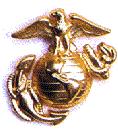 with the U.S. Marines and
began our "Semper Fi" indoctrination at the Field Medical School at Camp
Pendleton, California in January, 1969. After experiencing field ambushes, C-rats,
marching drills and survival training, our group graduated from the school and spread out
to various duty assignments at 3rd Marine Air Wing Stations at Santa Ana and El Toro,
California to await the inevitable transfer to Vietnam.
with the U.S. Marines and
began our "Semper Fi" indoctrination at the Field Medical School at Camp
Pendleton, California in January, 1969. After experiencing field ambushes, C-rats,
marching drills and survival training, our group graduated from the school and spread out
to various duty assignments at 3rd Marine Air Wing Stations at Santa Ana and El Toro,
California to await the inevitable transfer to Vietnam.
My orders to report to DaNang, Republic of Vietnam in July, 1969 arrived and on the
historic day of man's landing on the moon, I joined several others for a polar route
flight from Norton Air Force Base in Southern California to Vietnam via Alaska, Japan and
Okinawa to begin my 1st Marine Air Wing adventures. My assignment was to the MWSG-17
Squadron in DaNang, located on the north side of the main DaNang airfield. The right
side of the photo is an aerial view of the squadron area. The squadron was involved
in multiple support missions for the other Marine Air Wing squadrons and ground units
located throughout the "I Corp" area of Vietnam, including other units in DaNang
as well as Chu Lai, Phu Bai, An Hoa, Hue and Khe Sahn.
| Aerial view of DaNang airfield with MWSG-17 on the right | French style living in DaNang | Marine Wing Support Group-17 Medical Department |
One of the duties of our medical department was to provide support to Navy and Marine pilots who might need medical assistance after landing at the DaNang airfield. This support function led to one of the most exciting flying adventures in which I participated. As a result of assisting the pilot of an A-6 from the carrier USS Ranger who made an emergency landing at DaNang, I was invited to visit the USS Ranger and participate in carrier flight operations. A few months after this encounter, I picked up a COD flight to the USS Ranger operating in the Gulf of Tonkin and experienced a carrier catapult launch and landing in an A-6 Intruder. This experience was the highlight of my flying carrier with the U.S. Navy.
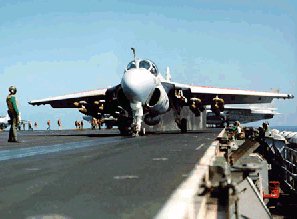 |
|||
| Another day at the office | Are you ready? | Zero to 140 knots in 168 feet | F-4 night launch |
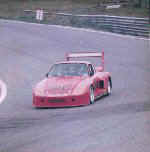 |
After leaving the Marines behind, my next adventure began with the purchase of a new 1972 911 T Porsche. My interest in sports car racing began to expand and after several modifications and racing class advancements, the original car evolved into the race car you see here. The original car migrated through several improvements and eventually competed at a weight of 1700 pounds with an engine producing 325 horsepower. In 1985, while living in Truckee, California, and partnered with Mat Lowrance of Sport Haus in Reno, Nevada, the car was entered in the Golden Gate Porsche Club's Time Trial Series at Sears Point Raceway and Laguna Seca Raceway and achieved a first (Mat) and second (Dave) place finish to win the five race series. | ||
| In the above picture, the car is entering
Turn 8 after the downhill run from Laguna Seca's well known "corkscrew" turn.
|
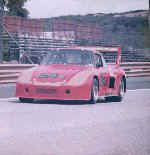 |
After the successful 1985 season, the fateful decision to increase the displacement of the engine was made and mixed results followed. Lap times at Sears Point and Laguna Seca tracks improved, but several events ended in frustration with broken parts. Body modifications were also made and the car ended up competing as an open roadster after the roof was removed in a failed project to exchange the car's metal roof for one made of fiberglass. After finishing several events with no points, the car was temporarily retired for a hiatus of three years and placed under tarps on a trailer in Truckee. | |
| The crowning achievement for myself was the final race of the 1985 season. During that season, Mat and I had done very well as a team and entering this final race we were well positioned in the point standings. However, I had not yet accomplished the individual goal all drivers have - winning. This final race in October provided that opportunity with a fast second lap that lifted my fourth place starting grid position to a "top time of day" performance. It could not have been done without Mat's technical assistance and support. | 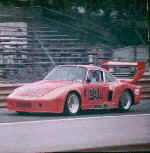 |
In the picture at left, the car is
crossing the Laguna Seca finish line with the pit wall in the foreground.
|
|
| The final achievement of our racing experience occurred when the car was brought out of retirement for a final assault on Sears Point Raceway in 1993. The event was the final time trial race of that season and as things turned out, the car was definitely still very competitive. Mat worked out the car's kinks from the three year hiatus and our lap times steadily dropped as the weekend progressed. The time trial lap record at that time was 1:43.2 and on Sunday morning, Mat came within half a second of the record while running in heavy traffic. When the dust settled on the unlimited modified six cylinder class run on Sunday afternoon, Mat had won the event and set a new course record with a lap time of 1:42.8. I finished second to complete a sweep of the modified class. It was an exhilarating way to finish an exciting racing career. | 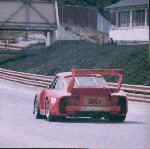 |
||
* * * *
![]()
![]()